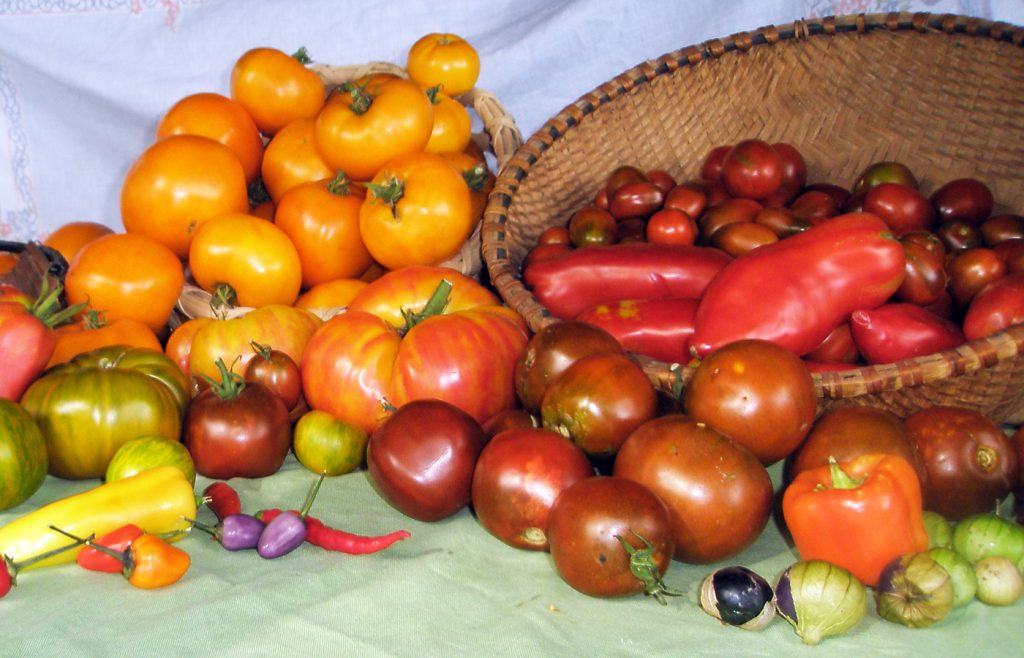
No fruit or vegetable quite exemplifies summer like a perfectly ripe, juicy tomato. Although we can get tomatoes in grocery stores year round, store-bought tomatoes cannot hold a candle to a fresh tomato picked right from the garden.
Beyond the exquisite flavor and beauty of a tomato vine loaded with delicious, brightly colored berries, tomatoes are versatile like almost no other produce. They can be used raw in a salad to highlight their sweetness or in salsa to accentuate their acidity. They can be cooked to enhance the flavor of many things—from paella to pasta, enchiladas to soup.
Furthermore, tomatoes lend themselves to storage extremely well. Home-dried tomatoes have just as much, if not more, flavor as store-bought sundried tomatoes, as well as costing a fraction of the price. Fresh tomatoes can be frozen to be cooked in the middle of winter or canned whole, or as sauce or salsa. Canned tomatoes can be stored for several years in a cool, dark place.
As a professional chef in Boulder, CO, for two years, then a cook on a permaculture homestead for two years, and now as garden-based educator, I have learned some tricks to bring out the most a tomato has to offer. I’d like to share some ideas for delicious ways to prepare these wonderful fruits (see tomato recipes), but first, here’s a little background.
Peruvian Origins
The tomato is believed to have originated in the highlands of Peru, as that is the center of the greatest diversity among wild tomato species. In its native range the tomato is a perennial sprawling vine. In tropical and warm subtropical climates, gardeners are able to grow individual tomato plants for many years. One Florida grower has boasted 30-foot-tall plants. Farther north growers must settle for growing tomatoes as annuals—although in a heated greenhouse they would thrive even in winter.
In the 15th century, conquistadors brought the tomato back to Europe from the New World, where the Spanish first encountered this tropical fruit. In fact, the word “tomato” is descended from the Aztec name xitomatl, which, along with other genetic evidence, suggests that despite the wild plant originating in South America, the tomato was first domesticated in Central America. This first garden tomato may very well have been a small cherry type.
In Europe the tomato was adopted by cooks all along the Mediterranean. The reason many Americans associate tomatoes with Italian food stems from the fact that Italians adopted the tomato soon after its discovery. By the time many Italians immigrated to the Atlantic seaboard in the late 19th century, tomatoes had been part of the Italian peasant diet for generations.
Northern Europeans admired the plant as an ornamental yet shied away from it as food, since many of its relatives in the nightshade family were known for their toxicity. Thomas Jefferson is widely credited with breaking the “poisonous tomato myth” by growing and serving tomatoes at his estate in Virginia. By the time the Civil War had ended, the tomato had become a staple garden vegetable and has remained so ever since.
Thousands of Flavors & Shapes
The globetrotting history of tomato has led to a great diversity of shapes, sizes, and flavors, with over 7,500 varieties. Beyond the commonplace red tomato, there are dime-size currant tomatoes and dinner-plate-size Brandywine tomatoes. There are orange Persimmons, Green Zebras, Black Plums, and multicolored Pineapples. Heirloom varieties have a whole range of tastes and textures not found in standard red types. Many are sweeter and lower in acid, while it is possible to find some that are even sharper in taste. White tomatoes are some of the sweetest I have ever tasted, while Russian Black tomatoes taste like a BLT sandwich! Some varieties, like Sun Gold and White Currant, are sweet enough to eat as dessert. Others, with lower water content, have been bred for drying and canning.
On the Galapagos Islands, an endemic tomato that’s found nowhere else on earth—an orange cherry tomato with curly leaves—is currently the focus of breeders who hope to capture its disease-resistant and early ripening qualities for new hybrid varieties. I grow a variety called Anasazi, obtained from a farmer in Boulder, CO, who said the seeds were found in an ancient pueblo. This variety is a low-acid sweet fruit about the size of a standard tomato. Its maroon-rust color fades to green near the stem, and the flesh is almost purple. By growing this tomato, I feel a sense of history.
